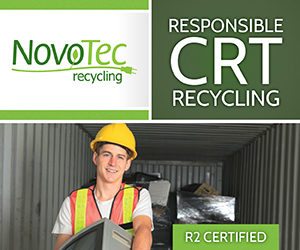In less than half a decade, the Closed Loop Fund has become a household name in the recycling industry, putting sizable capital behind a range of materials recovery initiatives. A leader from the investment effort recently put the fund’s path into perspective.
The Closed Loop Fund was formed in 2014, when nine major corporations tied to the consumer products sector put together $100 million with the goal of boosting infrastructure and technology in the recycling industry. The fund would act as a low- or no-interest lending vehicle for promising projects.
By March of this year, the fund had lent its capital to nearly a dozen efforts, and has announced more recipients since then.
The model of private companies injecting money into public materials diversion infrastructure is not exclusive to Closed Loop. The Recycling Partnership also launched in early 2014, and the two groups have in some cases pooled their people and resources.
Resource Recycling talked with Rob Kaplan, managing director of Closed Loop Partners, an umbrella organization that includes the Closed Loop Fund. He discussed the project’s tactics and progress as well as challenges it has encountered in the market, such as “free rider” companies that benefit from the fund’s efforts without actually putting money behind it.
Progress to date
Although the fund has garnered substantial attention since its launch, its tonnage impact has only grown to substantial figures more recently. That’s to be expected, Kaplan noted, as building municipal infrastructure takes a long time.
In 2016, work financed through the fund contributed to diversion of about 100,000 tons, according to the organization. Thus far in 2017 the fund has already “far exceeded” that number, Kaplan said.
Kaplan added he had expected the fund would have more corporate partners at this point. Its investors are companies who have taken the fund’s goals to heart, and are looking at their investments as a way of bolstering the long-term health of their supply chain.
But given the fact those investment dollars often go toward public-sector projects or private companies that are using pilot projects to push technology forward for the whole industry, “there are lots of other brands and companies that will benefit from that, who aren’t taking that leadership position,” Kaplan said.
It’s difficult to combat that “free rider” phenomenon, said Kaplan, but he predicts more partners will be attracted as the fund demonstrates it can deliver results, thereby presenting a clearer business case.
He also said he expects more corporate players to become interested in boosting recycling once they move through the process of optimizing materials recovery within their own stores, facilities or offices.
“Once you figure it out, get your own house in order, is when corporate and large consumer goods companies start thinking about their supply chain and the opportunities to optimize in waste and other sustainability,” Kaplan said.
Recognizing need in supply chain
The public-private financial model was chosen to tackle a unique dynamic that had developed within the retail supply chain and the recycling industry. Major companies, including Walmart, made it a focus to increase the use of recycled content in packaging for products within their supply chains, Kaplan said. But they ran into a problem
“We couldn’t get the quality and quantity of material into the supply chain that we needed in order to achieve the scale that we needed,” said Kaplan, who was helping to lead sustainability at Walmart when the Closed Loop Fund formed.
Laura Phillips, Walmart’s current senior vice president of corporate affairs and sustainability, said the company started out by looking inward at waste in its own operations. Out of its internal work, the company developed an interest in tackling waste on a more “end-to-end” scale, she said.
Walmart began “looking up in the supply chain from producer, supplier, and then looking down, to the customer level,” she noted. Particularly when looking downstream to the customer, the company learned there was a lot of work to be done to help allow customers to easily recycle in their communities.
Providing support to municipal programs would boost diversion of packaging materials sold by the company, which would be in line with Walmart’s waste reduction goals. And it would also inject more material into the recycling stream that could end up as recycled content for suppliers.
“All of the brands and suppliers in the consumer goods industry would benefit if recycling worked better, but they weren’t the ones who owned the infrastructure,” Kaplan said. “If the infrastructure was built, they could see value, but no one was investing in building that infrastructure. So there was this tension in the system, and that’s why we created the Closed Loop Fund: to break through that tension.”
Next steps for investment
Kaplan said the Closed Loop Fund breaks down recycling investment into three sectors: collection, sorting, and processing and end markets. Much like materials moving through the recycling system, the fund’s investment timeline has followed that order as well.
Investment began in the municipal sector, with projects transitioning two Midwest communities to single-stream recycling. The fund also supported a Chicago-area MRF and a Maryland plastics recovery facility (PRF).
The plastics facility, a joint venture between QRS Recycling and Canusa Hershman Recycling, announced earlier this month it was idling operations to improve its system. Kaplan said such hiccups are to be expected when working with new kinds of sortation systems..
This year, the fund moved into the area of end markets, funding companies using recovered plastic and glass for new products.
Kaplan said there are other types of funding opportunities the project would like to explore, beyond those three sectors. For instance, the Closed Loop Fund team has floated the idea of a large-scale project, to the tune of $25 million or $30 million, that would support an entire region’s recycling “eco-system.” The investment would help a community determine where carts are needed, which MRF upgrades are needed, and where local end-market deficiencies exist. The goal would be to tackle inter-connected issues at the same time.
“Cities can do the best job collecting, but if they don’t have a MRF that is operating with optimal efficiency, it doesn’t really matter how good they are at collecting,” Kaplan said. “Or if you have a MRF operating at optimal efficiency but they’re not near an end market for the material, it doesn’t matter how clean their bales are if they have to ship it too far.”
Beyond the fund
The Closed Loop Fund has placed emphasis on co-investment in the projects it funds. Kaplan noted that although $100 million is a lot of money, to fully realize its potential the fund looks to act as a “catalyst” that will convince other investors of the viability of recycling industry investments. The additional capital the fund can “unlock” through attracting co-investment is also important given the scope of the issues it seeks to tackle.
“It needs to be much more than $100 million that we’re able to deploy, because this is a billion dollar problem,” Kaplan said.
But that money is planned to be fully invested during the next few years, leading some to consider the future after the fund reaches its investment target.
The success of the funding models used by projects like the Closed Loop Fund and The Recycling Partnership suggests they could see expansion in the future. Their success makes the value proposition clearer for other corporate players, Kaplan said. But in the long term, he doesn’t think this sort of subsidized funding model will or should continue forever.
“The goal is to have healthy markets that subsidize themselves, that fulfill themselves,” he said.
The investment fund is about halfway through its expected lifespan, with nearly half its funds deployed, and a deadline of 2020 to invest all its capital. Now, some of the focus is shifting to the next stage, and how best to continue infrastructure support work.
“We’ve proven some really exciting things so far, which a lot of people didn’t believe when we started,” he said. “Originally people would say, ‘Would cities ever take this money? Can’t they just float a bond?’ We’ve shown that they can, and will and do. So, ‘What does that look like at scale?’ is now more of the question.”



























